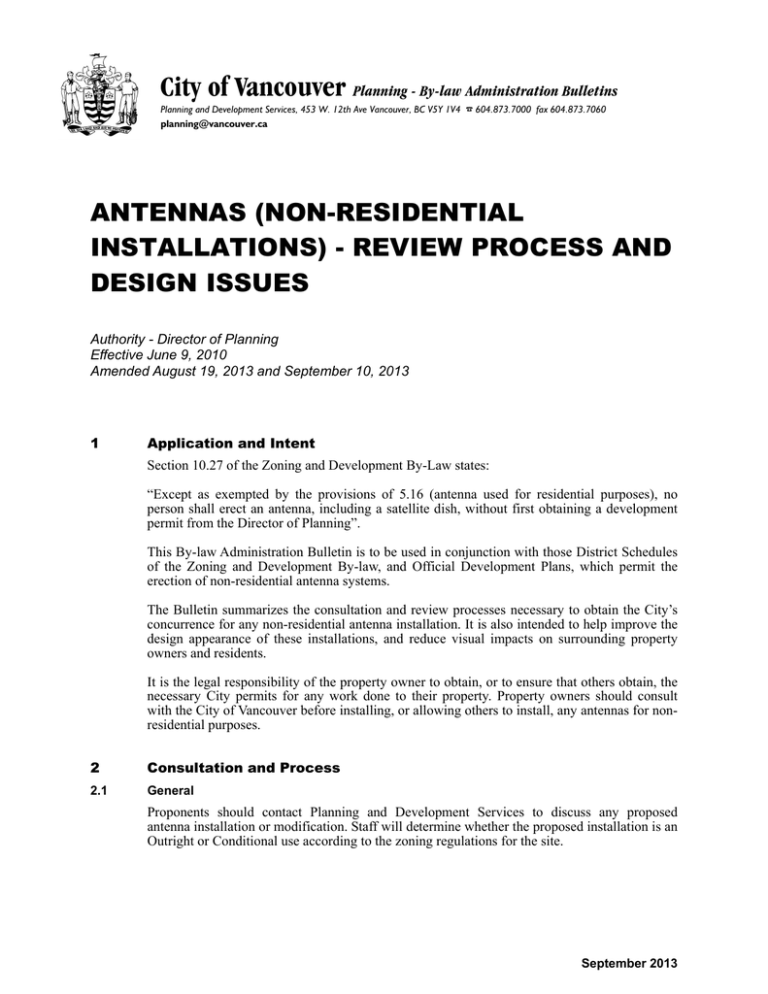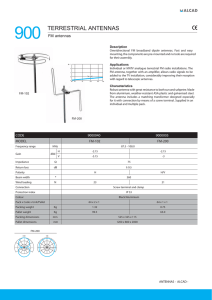(non-residential installations) - Review Process
advertisement

City of Vancouver Planning - By-law Administration Bulletins Planning and Development Services, 453 W. 12th Ave Vancouver, BC V5Y 1V4 F 604.873.7000 fax 604.873.7060 planning@vancouver.ca ANTENNAS (NON-RESIDENTIAL INSTALLATIONS) - REVIEW PROCESS AND DESIGN ISSUES Authority - Director of Planning Effective June 9, 2010 Amended August 19, 2013 and September 10, 2013 1 Application and Intent Section 10.27 of the Zoning and Development By-Law states: “Except as exempted by the provisions of 5.16 (antenna used for residential purposes), no person shall erect an antenna, including a satellite dish, without first obtaining a development permit from the Director of Planning”. This By-law Administration Bulletin is to be used in conjunction with those District Schedules of the Zoning and Development By-law, and Official Development Plans, which permit the erection of non-residential antenna systems. The Bulletin summarizes the consultation and review processes necessary to obtain the City’s concurrence for any non-residential antenna installation. It is also intended to help improve the design appearance of these installations, and reduce visual impacts on surrounding property owners and residents. It is the legal responsibility of the property owner to obtain, or to ensure that others obtain, the necessary City permits for any work done to their property. Property owners should consult with the City of Vancouver before installing, or allowing others to install, any antennas for nonresidential purposes. 2 Consultation and Process 2.1 General Proponents should contact Planning and Development Services to discuss any proposed antenna installation or modification. Staff will determine whether the proposed installation is an Outright or Conditional use according to the zoning regulations for the site. September 2013 2.2 Outright and Conditional Uses Depending on their specific purpose, non-residential antennas will generally be classified as either a Public Utility use or a Radiocommunication Station under the Zoning and Development By-Law. Radiocommunication Station is an Outright use in many Industrial zones and a Conditional use in many Commercial zones. Public Utility use is a Conditional use in all zoning districts and Official Development Plans in the City of Vancouver. If you are unsure of the zoning or use issues with respect to a specific installation or site, please contact the Enquiry Centre of Development Services. Outright uses: Under the provisions of the Zoning and Development By-Law, Outright uses are approvable subject to compliance with regulations only (e.g. height, yards, etc.). Applicants should refer to the relevant District Schedule for the applicable regulations. Conditional uses: In addition to compliance with regulations, Conditional uses require the discretionary review of the Director of Planning. In considering any Conditional use, the Director of Planning is required to consider impacts on surrounding residents, as well as a range of urban and architectural design issues. Notification of surrounding property owners by letter may be undertaken if impacts are considered significant. 2.3 Consultation and Processing Outright uses: If the use is Outright under the relevant District Schedule and if the installation meets all regulations of the Schedule, an application for a combined Development Building Permit may be made. In this approval stream, Planning issues can be cleared at the time of application, and the application is then forwarded to the Building Group. The Building Group will review the antenna installation for compliance with the Vancouver Building Bylaw. Structural letters of assurance from a Professional Engineer registered in the Province of British Columbia will be required. The issuance of a combined Development Building Permit will indicate the City’s concurrence with the proposed installation. Conditional uses: If the use is Conditional, or if any relaxation of zoning regulations is required, proponents will be asked to meet with a Development Planner to discuss the proposal. If Planning issues or concerns can be resolved through this discussion, and if the City concludes that additional consultation with surrounding property owners is not required, the combined Development Building Permit process may also be used. For situations where Planning issues cannot be resolved through a simple discussion process, or in those instances where the City determines that direct consultation with affected property owners is required, separate Development Permit and Building Permit applications will be required. The City will undertake formal notification of affected property owners as part of the Development Permit process. Issuance of separate Development and Building Permits will indicate the City’s concurrence with the proposed installation. 3. Design Issues Every antenna installation is different and should be carefully considered by the applicant and staff, for its location, design and potential impacts on neighbours and the public realm. The following General Design Principles should be used in conjunction with the “Cellular Antennas and Urban Integration: Design Guidelines”, as a guide in achieving an acceptable design. City of Vancouver Antennas (non-residential installations) - Review Process and Design Issues September 2013 Page 2 3.1 General Design Principles Design concerns fall under three main categories: (a) Impacts on Adjacent Property Owners or Tenants Applicants and staff should consider impacts on views, and the visibility and general appearance of installations as seen from surrounding or neighbouring properties. (b) Impacts on Building Design Refer to the “Cellular Antennas and Urban Integration: Design Guidelines” (Appendix A) as a guide to identify approvable locations for antennae infrastructure mounted on buildings. Staff may consider locations which do not meet the criteria set in the “Cellular Antennas and Urban Integration: Design Guidelines” on a discretionary, case-by-case basis. (c) General Urban Design This is a review of any impact on the general public realm, streetscape, or overall urban environment. 3.2 Design Principles and Considerations for Antenna on Buildings (a) Location While every installation is different, the attached “Cellular Antennas and Urban Integration: Design Guidelines” as Appendix A is a guide in achieving an acceptable design and should be carefully considered by the applicant and staff. (b) Colour Antennae, and if required their shrouds, should be finished in a colour to suit their location and be visibly unobtrusive. Colour will vary depending on the context and the design approach taken. Shroud material may also vary depending on the design approach and be generally non-reflective. (c) Building Suitability Not all buildings are suitable for cell antenna installations. Some buildings may already have a large number of antennas, and additional installations may not be possible without negatively impacting the appearance of the building or affecting views. The “Cellular Antennas and Urban Integration: Design Guidelines” is to serve as a guide and proposals that comply with the “Cellular Antennas and Urban Integration: Design Guidelines” are expected to simplify the process of permit issuance. (d) Heritage and Architecturally Distinctive Buildings Buildings listed on the Vancouver Heritage Register require special attention, and may not be appropriate for any installations. Other buildings which are not listed on the Heritage Register, but which have particular architectural merit, may not be appropriate for antenna installations. Where an installation is necessary, consultation with Heritage Planning staff is encouraged to consider the most appropriate design solution for the building. City of Vancouver Antennas (non-residential installations) - Review Process and Design Issues September 2013 Page 3 (e) Mechanical Equipment The visibility of mechanical equipment should be limited. Small amounts of equipment (cabinets) may be mountable on the flat roof of a larger building, adjacent to an existing mechanical penthouse and located in a manner to limit visibility from surrounding buildings. For larger installations however, locating the equipment within the building (in an existing mechanical space or a basement) may be expected. 3.3 Principles and Considerations for Freestanding Towers/Monopoles Freestanding tower or monopole construction may be warranted where co-location, buildings and street infrastructure are not of sufficient height or appropriately located to provide effective service levels. The City supports industry proposals for free-standing cellular antenna tower/monopoles as a choice of last resort. Applications should demonstrate potential for alternate solutions such as co-location, antenna on buildings and street infrastructure prior to consideration of a tower/monopole. Where it is determined that a new free-standing cellular tower/monopole is required on private land in the absence of alternative solutions to improve the demand for wireless service in residential or commercial neighbourhoods, public consultation and engagement by the applicant may be required for any installation 9 metres and higher. All new free-standing cellular tower/monopole proposals over 9 metres on private land in residential or commercial zoned property or proximate to residential districts or existing residential development will be processed as separate Development and Building permits with City public notification. Proponents are required to contact Planning and Development Services and discuss their proposal with a development planner prior to an application, discuss design parameters and alternative solutions to tower/monopoles, prospects for co-location, siting, and public engagement including notification. Proposals need to demonstrate their compliance with Health Canada Code 6 and Vancouver Coastal Health standards for radio frequency emissions. Careful consideration of architectural design, site planning and view impacts should comprise an important part of the review of the permit application. Proposals for temporary mobile cellular antenna installations associated with a Special Event shall contact the Manager, Film and Special Events Office at 311. City of Vancouver Antennas (non-residential installations) - Review Process and Design Issues September 2013 Page 4


